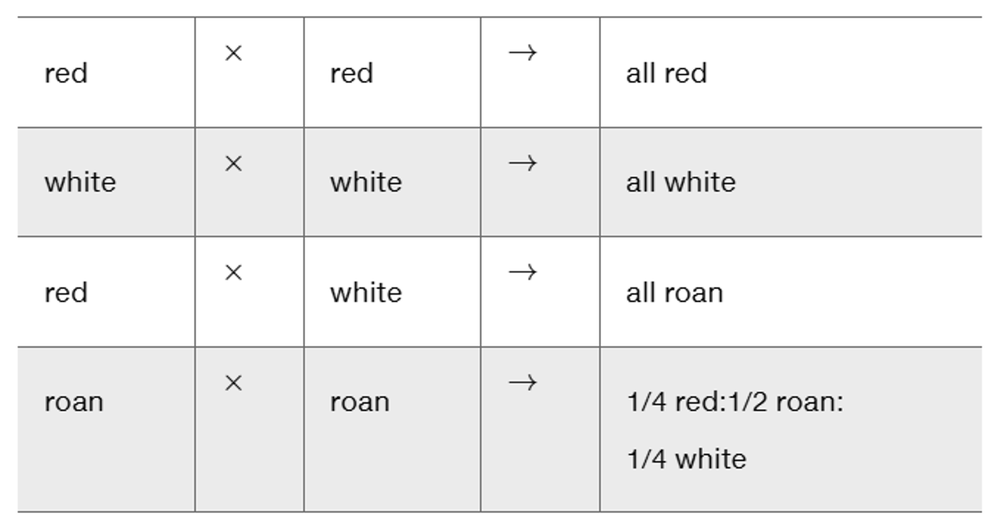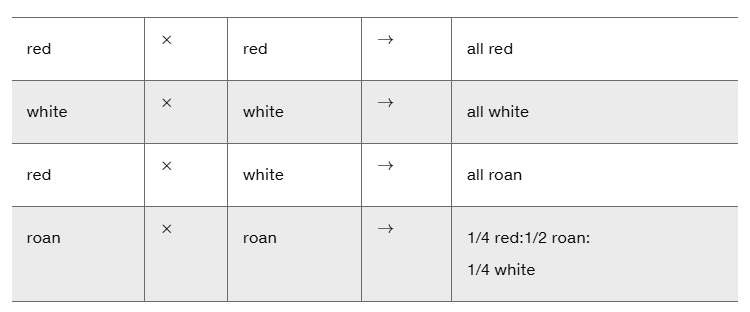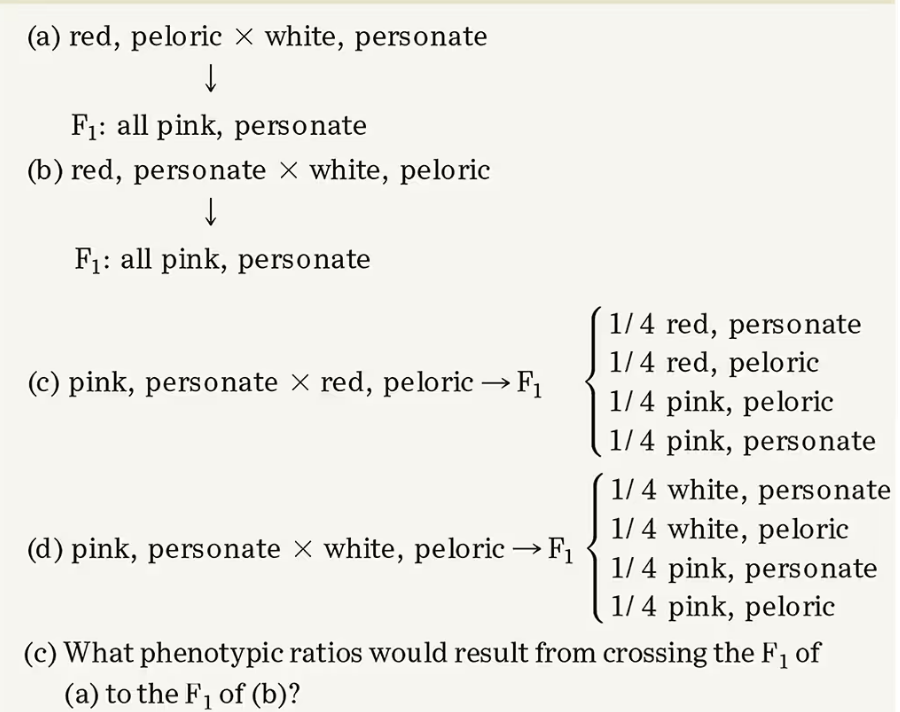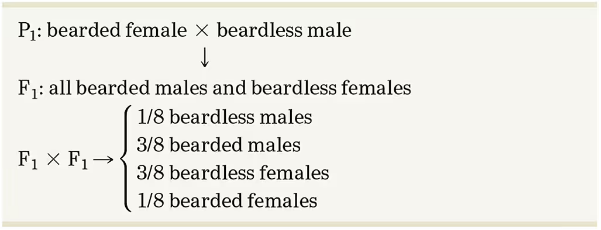 Back
BackProblem 1b
In the discussion, we focused on extensions and modifications of Mendelian principles and ratios. In the process, we encountered many opportunities to consider how this information was acquired. On the basis of these discussions, what answers would you propose to the following fundamental questions?
How did geneticists determine that inheritance of some phenotypic characteristics involves the interactions of two or more gene pairs? How were they able to determine how many gene pairs were involved?
Problem 1c
The discussion centers on extensions and modifications of Mendelian principles and ratios. In the process, we encountered many opportunities to consider how this information was acquired. On the basis of these discussions, what answers would you propose to the following fundamental questions?
How do we know that specific genes are located on the sex-determining chromosomes rather than on autosomes?
Problem 1d
The discussion centers on extensions and modifications of Mendelian principles and ratios. In the process, we encountered many opportunities to consider how this information was acquired. On the basis of these discussions, what answers would you propose to the following fundamental questions?
For genes whose expression seems to be tied to the sex of individuals, how do we know whether a gene is X-linked in contrast to exhibiting sex-limited or sex-influenced inheritance?
Problem 1e
Answer the following fundamental questions:
How was extranuclear inheritance discovered?
Problem 3a
In shorthorn cattle, coat color may be red, white, or roan. Roan is an intermediate phenotype expressed as a mixture of red and white hairs. The following data were obtained from various crosses:
How is coat color inherited? What are the genotypes of parents and offspring for each cross?
Problem 3b
In shorthorn cattle, coat color may be red, white, or roan. Roan is an intermediate phenotype expressed as a mixture of red and white hairs. The following data were obtained from various crosses:
Does the roan phenotype illustrate a case of incomplete dominance or a case of codominance? Explain.
Problem 4
With regard to the ABO blood types in humans, determine the genotype of the male parent and female parent shown here:
Male parent: Blood type B; mother type O
Female parent: Blood type A; father type B
Predict the blood types of the offspring that this couple may have and the expected proportion of each.
Problem 5
In foxes, two alleles of a single gene, P and p, may result in lethality (PP), platinum coat (Pp), or silver coat (pp). What ratio is obtained when platinum foxes are interbred? Is the P allele behaving dominantly or recessively in causing (a) lethality; (b) platinum coat color?
Problem 6
Three gene pairs located on separate autosomes determine flower color and shape as well as plant height. The first pair exhibits incomplete dominance, where the color can be red, pink (the heterozygote), or white. The second pair leads to personate (dominant) or peloric (recessive) flower shape, while the third gene pair produces either the dominant tall trait or the recessive dwarf trait. Homozygous plants that are red, personate, and tall are crossed to those that are white, peloric, and dwarf. Determine the F₁ genotype(s) and phenotype(s). If the F₁ plants are interbred, what proportion of the offspring will exhibit the same phenotype as the F₁ plants?
Problem 7
Flower color may be red, white, or pink, and flower shape may be personate or peloric. For the following crosses, determine the P₁ and F₁ genotypes:
Problem 8a
In rats, the following genotypes of two independently assorting autosomal genes determine coat color:
A third gene pair on a separate autosome determines whether or not any color will be produced. The CC and Cc genotypes allow color according to the expression of the A and B alleles. However, the cc genotype results in albino rats regardless of the A and B alleles present. Determine the F₁ phenotypic ratio of the following crosses:
AAbbCC×aaBBcc
Problem 8c
In rats, the following genotypes of two independently assorting autosomal genes determine coat color:
A third gene pair on a separate autosome determines whether or not any color will be produced. The CC and Cc genotypes allow color according to the expression of the A and B alleles. However, the cc genotype results in albino rats regardless of the A and B alleles present. Determine the F₁ phenotypic ratio of the following crosses:
AaBbCc×AaBbcc
Problem 9a
Given the inheritance pattern of coat color in rats described in Problem 17, predict the genotype and phenotype of the parents who produced the following offspring:
9/16 gray: 3/16 yellow: 3/16 black: 1/16 cream
Problem 9b
Given the inheritance pattern of coat color in rats described in Problem 17, predict the genotype and phenotype of the parents who produced the following offspring:
9/16 gray: 3/16 yellow: 4/16 albino
Problem 9c
Given the inheritance pattern of coat color in rats described in Problem 17, predict the genotype and phenotype of the parents who produced the following offspring: 27/64 gray:
16/64 albino: 9/64 yellow: 9/64 black: 3/64 cream
Problem 10
A husband and wife have normal vision, although both of their fathers are red–green color-blind, an inherited X-linked recessive condition. What is the probability that their first child will be (a) a normal son, (b) a normal daughter, (c) a color-blind son, (d) a color-blind daughter?
Problem 11
In humans, the ABO blood type is under the control of autosomal multiple alleles. Color blindness is a recessive X-linked trait. If two parents who are both type A and have normal vision produce a son who is color-blind and is type O, what is the probability that their next child will be a female who has normal vision and is type O?
Problem 12
In goats, the development of the beard is due to a recessive gene. The following cross involving true-breeding goats was made and carried to the F₂ generation:
Offer an explanation for the inheritance and expression of this trait, diagramming the cross. Propose one or more crosses to test your hypothesis.
Problem 13
In cats, orange coat color is determined by the b allele, and black coat color is determined by the B allele. The heterozygous condition results in a coat pattern known as tortoiseshell. These genes are X-linked. What kinds of offspring would be expected from a cross of a black male and a tortoiseshell female? What are the chances of getting a tortoiseshell male?
Problem 13a
In cats, orange coat color is determined by the b allele, and black coat color is determined by the B allele. The heterozygous condition results in a coat pattern known as tortoiseshell. These genes are X-linked. What kinds of offspring would be expected from a cross of a black male and a tortoiseshell female? What are the chances of getting a tortoiseshell male?
Problem 14
In Drosophila, an X-linked recessive mutation, scalloped (sd), causes irregular wing margins. Diagram the F₁ and F₂ results if (a) a scalloped female is crossed with a normal male; (b) a scalloped male is crossed with a normal female. Compare these results with those that would be obtained if the scalloped gene were autosomal.
Problem 15
Another recessive mutation in Drosophila, ebony (e), is on an autosome (chromosome 3) and causes darkening of the body compared with wild-type flies. What phenotypic F₁ and F₂ male and female ratios will result if a scalloped-winged female with normal body color is crossed with a normal-winged ebony male?
Work out this problem by both the Punnett square method and the forked-line method.
Problem 16a
While vermilion is X-linked in Drosophila and causes the eye color to be bright red, brown is an autosomal recessive mutation that causes the eye to be brown. Flies carrying both mutations lose all pigmentation and are white-eyed. Predict the F₁ and F₂ results of the following crosses:
vermilion females x brown males






